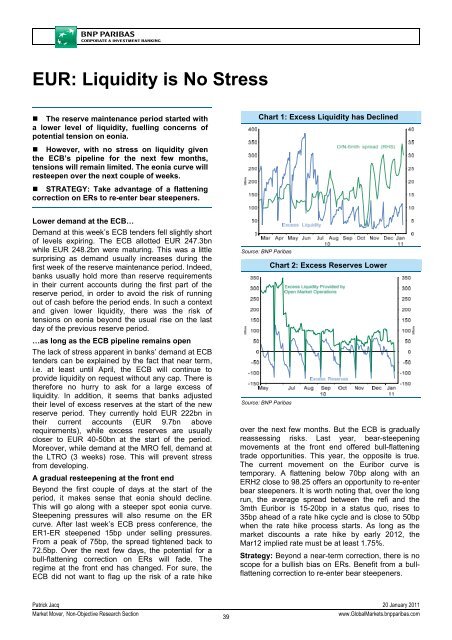Market Economics | Interest Rate Strategy - BNP PARIBAS ...
Market Economics | Interest Rate Strategy - BNP PARIBAS ...
Market Economics | Interest Rate Strategy - BNP PARIBAS ...
You also want an ePaper? Increase the reach of your titles
YUMPU automatically turns print PDFs into web optimized ePapers that Google loves.
EUR: Liquidity is No Stress<br />
• The reserve maintenance period started with<br />
a lower level of liquidity, fuelling concerns of<br />
potential tension on eonia.<br />
Chart 1: Excess Liquidity has Declined<br />
• However, with no stress on liquidity given<br />
the ECB’s pipeline for the next few months,<br />
tensions will remain limited. The eonia curve will<br />
resteepen over the next couple of weeks.<br />
• STRATEGY: Take advantage of a flattening<br />
correction on ERs to re-enter bear steepeners.<br />
Lower demand at the ECB…<br />
Demand at this week’s ECB tenders fell slightly short<br />
of levels expiring. The ECB allotted EUR 247.3bn<br />
while EUR 248.2bn were maturing. This was a little<br />
surprising as demand usually increases during the<br />
first week of the reserve maintenance period. Indeed,<br />
banks usually hold more than reserve requirements<br />
in their current accounts during the first part of the<br />
reserve period, in order to avoid the risk of running<br />
out of cash before the period ends. In such a context<br />
and given lower liquidity, there was the risk of<br />
tensions on eonia beyond the usual rise on the last<br />
day of the previous reserve period.<br />
…as long as the ECB pipeline remains open<br />
The lack of stress apparent in banks’ demand at ECB<br />
tenders can be explained by the fact that near term,<br />
i.e. at least until April, the ECB will continue to<br />
provide liquidity on request without any cap. There is<br />
therefore no hurry to ask for a large excess of<br />
liquidity. In addition, it seems that banks adjusted<br />
their level of excess reserves at the start of the new<br />
reserve period. They currently hold EUR 222bn in<br />
their current accounts (EUR 9.7bn above<br />
requirements), while excess reserves are usually<br />
closer to EUR 40-50bn at the start of the period.<br />
Moreover, while demand at the MRO fell, demand at<br />
the LTRO (3 weeks) rose. This will prevent stress<br />
from developing.<br />
A gradual resteepening at the front end<br />
Beyond the first couple of days at the start of the<br />
period, it makes sense that eonia should decline.<br />
This will go along with a steeper spot eonia curve.<br />
Steepening pressures will also resume on the ER<br />
curve. After last week’s ECB press conference, the<br />
ER1-ER steepened 15bp under selling pressures.<br />
From a peak of 75bp, the spread tightened back to<br />
72.5bp. Over the next few days, the potential for a<br />
bull-flattening correction on ERs will fade. The<br />
regime at the front end has changed. For sure, the<br />
ECB did not want to flag up the risk of a rate hike<br />
Source: <strong>BNP</strong> Paribas<br />
Source: <strong>BNP</strong> Paribas<br />
Chart 2: Excess Reserves Lower<br />
over the next few months. But the ECB is gradually<br />
reassessing risks. Last year, bear-steepening<br />
movements at the front end offered bull-flattening<br />
trade opportunities. This year, the opposite is true.<br />
The current movement on the Euribor curve is<br />
temporary. A flattening below 70bp along with an<br />
ERH2 close to 98.25 offers an opportunity to re-enter<br />
bear steepeners. It is worth noting that, over the long<br />
run, the average spread between the refi and the<br />
3mth Euribor is 15-20bp in a status quo, rises to<br />
35bp ahead of a rate hike cycle and is close to 50bp<br />
when the rate hike process starts. As long as the<br />
market discounts a rate hike by early 2012, the<br />
Mar12 implied rate must be at least 1.75%.<br />
<strong>Strategy</strong>: Beyond a near-term correction, there is no<br />
scope for a bullish bias on ERs. Benefit from a bullflattening<br />
correction to re-enter bear steepeners.<br />
Patrick Jacq 20 January 2011<br />
<strong>Market</strong> Mover, Non-Objective Research Section<br />
39<br />
www.Global<strong>Market</strong>s.bnpparibas.com

















